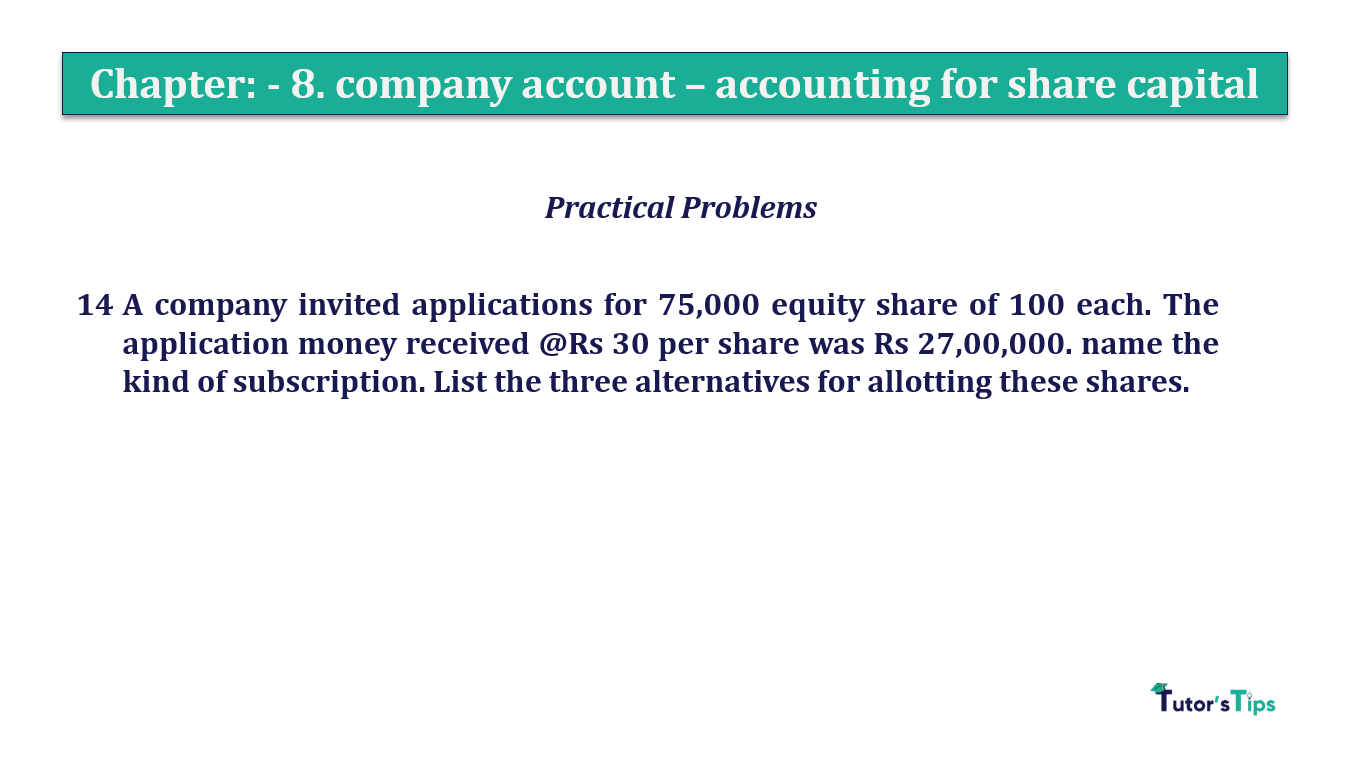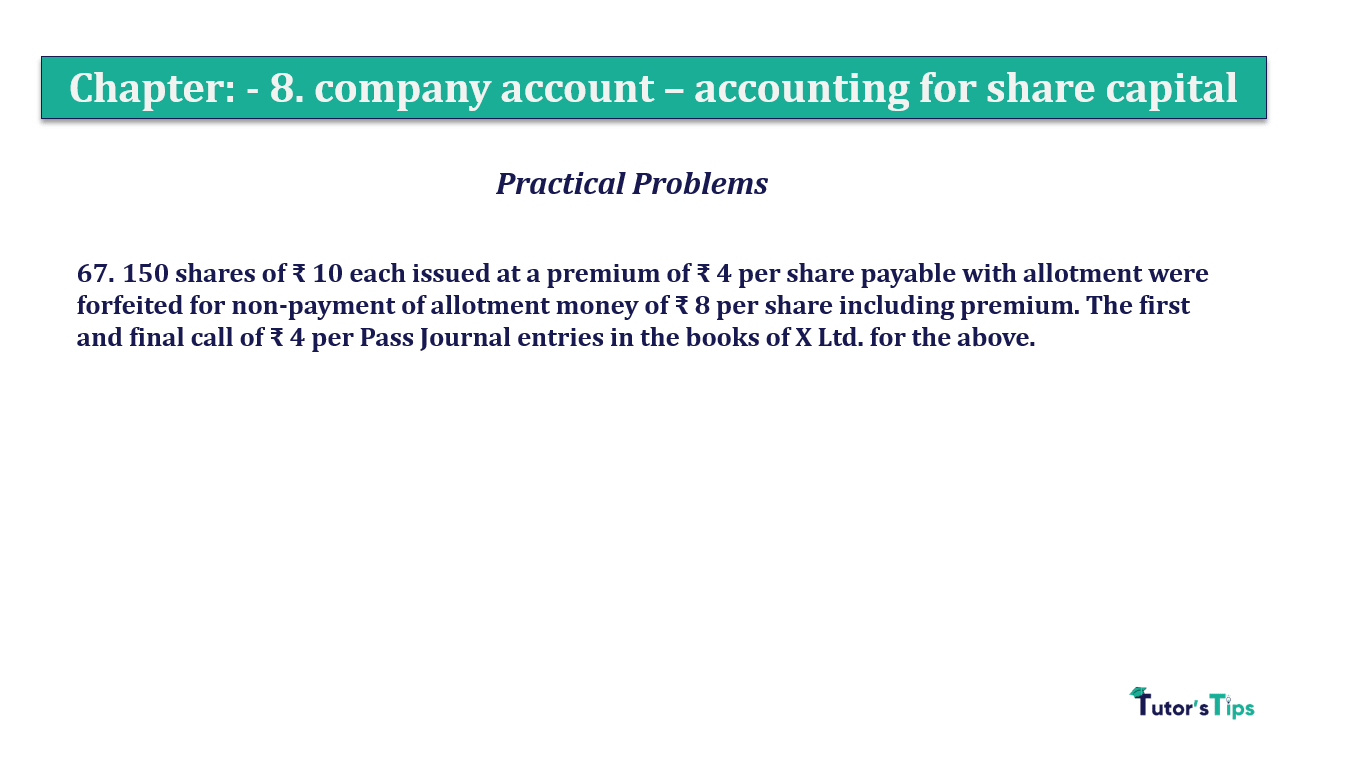Question 14 Chapter 8 of +2-A
14. A company invited applications for 75,000 equity share of 100 each. The application money received @Rs 30 per share was Rs 27,00,000. name the kind of subscription. List the three alternatives for allotting these shares.
The solution of Question 14 Chapter 8 of +2-A: –
In the case of this company, This type of share subscription is known as the oversubscription of shares.
It’s a kind of subscription that happens because of the number of shares were subscribed by the public more than the number of shares issued by the company in the share market. So, The company can be made allotment of share to the extent of the number of shares issued.
In this circumstance, a company can use 3 possible ways to tackle oversubscription. These are shown as follows: –
3. Reject the excess applied number of shares
2. Make Allotment on Pro-rata Basis to all public
3. Use a combination of both the above methods.
Rejection of excess applied number of shares –
Some of the subscribed application are accepted completely whereas other excess numbers of shares are rejected and application money of excess numbers of shares will be refunded.
For example, a company-issued 75,000 shares but application received for 90,000 shares. Then a company can accept 75000 shares and other 15000 excess shares are rejected and their application money is refunded.
| Number of shares issued | Number of application received | Number of excess shares | Number of allotted shares | Number of shares to whom money refunded |
| 75,000 | 90,000 | 15000 | 75,000 | 15,000 |
2 Make Allotment on Pro-rata Basis to all public
In this method, shares are allotted in proportion to all applicants.
For example: in the view of the above example, shares are allotted
to all the applicants in the fraction of 75,000 shares for every 90,000 shares applied.
| Number of appli- cation received |
Number of shares issued | Number of excess shares | Appli-cation Money Received (Rs.) @30 per share | Appli- cation money due (Rs.) |
Excess Amount left after Application | Amount Adjusted with Allotment (Rs.) |
| 90,000 | 75,000 | 15,000 | 2,700,000 | 2,250,000 | 450,000 | 450,000 |
Use a combination of both the above methods-
Advertisement-X
Some applications are accepted completely whereas some applications are rejected and allotment is made to remaining on a pro-rata basis.
For example, the company received applications for 90000n shares out of which 80000 shares are accepted but 10000 are rejected. And 80000 shares are adjusted in 75000 shares on a pro-rata basis.
| Number of appli-cation received | Number of shares issued | Number of excess shares | Appli-cation Money Received (Rs.)@30 per share | Appli-cation money due (Rs.) | Excess Amount left after Appli-cation | Amount Adjusted with Allot-ment (Rs.) | Amount Refund |
| 80,000 | 75,000 | 5,000 | 2,400,000 | 2,250,000 | 150,000 | 150,000 | – |
| 10,000 | – | 10,000 | 300,000 | – | 300,000 | – | 300,000 |
| 90,000 | 75,000 | 15,000 | 2,700,000 | 2,250,000 | 450,000 | 150,000 | 300,000 |
Thanks, Please Like and share with your friends
Comment if you have any question.
Also, Check out the solved question of previous Chapters: –
T.S. Grewal’s Double Entry Book Keeping +2 (Vol. I: Accounting for Not-for-Profit Organizations and Partnership Firms)
- Chapter No. 1 – Financial Statement of Not-For-Profit Organisations
- Chapter No. 2 – Accounting for Partnership Firms – Fundamentals
- Chapter No. 3 – Goodwill: Nature and Valuation
- Chapter No. 4 – Change in Profit-Sharing Ratio Among the Existing Partners
- Chapter No. 5 – Admission of a Partner
- Chapter No. 6 – Retirement/Death of a Partner
- Chapter No. 7 – Dissolution of a Partnership Firm
T.S. Grewal’s Double Entry Book Keeping (Vol. II: Accounting for Companies)
- Chapter No. 8 – Company Accounts – Accounting for Share Capital
- Chapter No. 9 – Company Accounts – Issue of Debentures
- Chapter No. 10 – Redemption of Debentures
T.S. Grewal’s Double Entry Book Keeping (Vol. II: Accounting for Companies)
- Chapter No. 1 – Financial Statements of a Company
- Chapter No. 2 – Financial Statement Analysis
- Chapter No. 3 – Tools of Financial Statement Analysis – Comparative Statements and Common- Size Statements
- Chapter No. 4 – Accounting Ratios
- Chapter No. 5 – Cash Flow Statement
Check out T.S. Grewal +2 Book 2020@ Official Website of Sultan Chand Publication








Leave a Reply